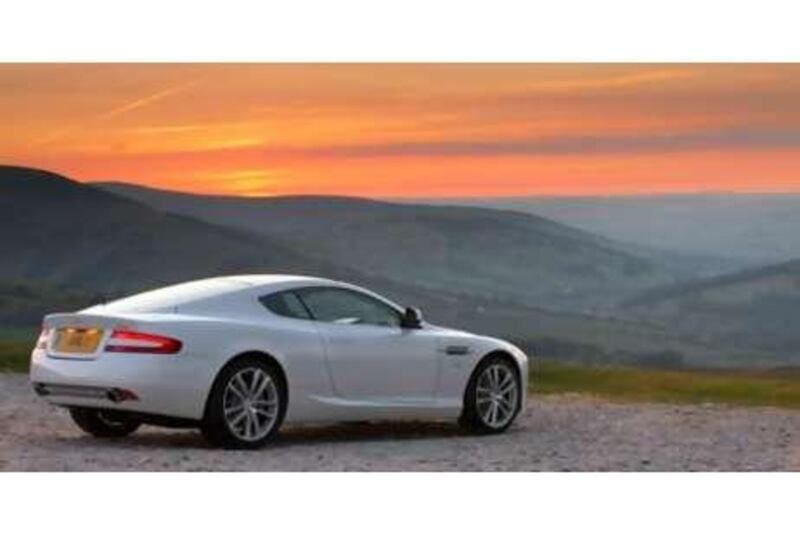As the old adage goes, if it ain't broke don't fix it. It must have been a mantra chanted within the Aston Martin design department when updating the DB9 because, unless you're a total anorak, you won't immediately see any difference between the 2011 model and the one that's been gracing the world's roads and showrooms since its debut in 2003. It's the most successful Aston Martin of all time and is the company's true backbone, so changing it in any way is bound to cause the occasional jitter. But change it they have, and to discover the real differences with this truly beautiful car you need to look beneath its flawless bodywork. But before we look at the most significant differences, let's just take a minute or two to consider the DB9's physical perfection.
I'm honest enough to admit that, when it comes to certain things in life, I can be as shallow as it's possible to be. And like many other things, if a car is truly beautiful to behold I can forgive it many wrongs. Because, when it comes to bidding a car goodnight, when you're shutting off the lights and closing the garage doors, if you have to just take one last, lingering look at it, then it's something truly special. And not many cars these days achieve that. The DB9 is one of those.
Designed by Henrik Fisker, it's nothing short of a modern classic. Try as I might, I cannot find a single awkward aspect of its design. It's magnificent - a purposeful, elegant yet aggressive and flowing shape that cannot, even after all these years, fail to cause jaws to hit the deck and have every single envious admirer reach for his or her mobile phone for a picture. Only true beauty can cause this sort of unflinching admiration and the DB9 has always had it by the truck-load.
So wisely, despite temptation to reinvent the classic, Aston's current design chief, Marek Reichman, has chosen to simply tweak the 9 and leave it basically intact. Exterior changes are limited to a new front bumper design, a new finish to the radiator grille and a reshaped lower air intake with a brightly finished hexagonal mesh. There are new headlamp bezels, restyled sills, new wheel designs and, wait for it, silver-painted brake callipers. Oh, and the rear lamp lenses are now clear as standard, just like the DBS. So far, so underwhelming. But like I say, there was nothing wrong with it in the first place.
The physical changes, though subtle, do make the DB9 look even better than before, but look closer and you'll find really far reaching improvements that transform the DB9 from GT cruiser to bona-fide sportscar. In fact the DB9 can now rightly claim supercar status and there isn't a spoiler or wing in sight. The clue to the DB9's newfound status can be found on the interior's centre console where there is a button showing a shock absorber icon; the same as you'd find in a DBS. Press it and you'll activate the sports suspension setting. "So what" I hear you cry - "the Porsche 911 and many other cars have been thus equipped for years." And yes, you'd be right. But here is a proper, adaptive suspension set-up (called Adaptive Damper System, just to add ADS to the DB9's list of acronyms).
Similar to the system already fitted in the DBS but tuned to suit the GT characteristics of this car, ADS practically reinvents the DB9. Back in 2006, in response to certain journalists' claims that the DB9 was just too soft to cut it in the real world, Aston Martin introduced the Sport Pack option, which lowered the car by 6mm and sharpened up its driving dynamics with lighter wheels (lower unsprung mass), resulting in improved steering feel. There were stiffer springs, a revised anti-roll bar, uprated dampers and a load-bearing undertray - all of which made for a more focussed driver's car. It was, in the big scheme of things, an absolute bargain and the world's motoring media loved it. But now, in the name of progress, ADS has done away with those things and it's fitted as standard equipment.
There are five damper settings available, adjusted by a central Adaptive Damping Electronic Control Unit (ECU) which takes readings from sensors placed around the car. These sensors not only take in information regarding the dynamic conditions being experienced but interpret the demands the driver is making at any given time. The ECU takes those measurements and adjusts the dampers to maximise contact with the road surface - either stiffening them up or softening them.
The driver has the choice between two of the five damper settings: "Normal" or "Sport" mode (via that new button) and the car's default setting when the ignition is activated is "Normal". However, even in this mode, ADS continually adjusts the dampers between its five settings, optimising body control at all times. The conventionally-sprung DB9 always impressed with its ability to smooth out road imperfections and retain composure during emergency braking, but with ADS it's in another league altogether. There's less body movement during acceleration and braking, particularly evident when I execute an emergency stop at 200kph. On roads where there is a continuously changing surface, the system takes everything in its stride and remains unfazed by whatever my route can throw at it.
Activating Sport mode, it's obviously a firmer ride. Yet even with the driver opting for the stiffest of the car's five damper settings, if the ECU determines that one side needs more grip than the other (during hard cornering, for example) it will automatically soften the appropriate dampers; what this does is maximise tyre/road contact at all times, which ultimately puts less stress on car and driver alike.
It's a truly brilliant advancement in the DB9's design and does nothing to tarnish its reputation as a fine, comfortable GT car - in fact, if anything, ADS enhances it. And when you consider that the system adjusts to the data received from the car's various sensors in a fraction of a second, it's reassuring to know it's always one step ahead, keeping everything in check so you don't have to. The gap is now closing between the DB9 and its brilliant DBS stablemate, its power deficiency now only really evident at speeds above 150mph, when it takes that bit longer to gather more momentum. Like the DBS, it's available in both Coupe and Volante (convertible) body styles and the drop-top is incredibly stiff in its structure, only generating the most minor wobbles on the most uneven roads. It's one of those rare cars that loses nothing in the looks department to its metal-roofed equivalent and its bonus is the fact you get to hear so much more of that masterpiece of a V12.
To help with weight distribution the standard six-speed manual gearbox is "rear mid-mounted" and there's an optional "Touchtronic 2" six-speed automatic transmission which is much improved over previous generations of DB9. It's lightning-quick in operation and, thankfully, holds onto your chosen ratio until you tell it otherwise - something that makes it feel much more like a sports car. The new DB9 is available to order in the Middle East, starting at Dh702,110, which is not exactly loose change but, if you sell the dog, house and everything else that's yours to buy one, you won't look back for a second - apart from when you're locking it up for the night.






